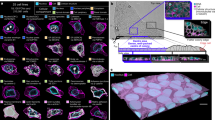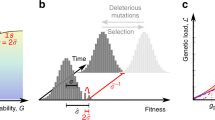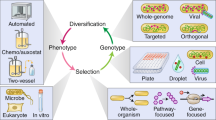Abstract
Cells somehow evolved from primordial chemistry and their emergence depended on the co-evolution of the cytoplasm, a genetic system and the cell membrane. It is widely believed that the cytoplasm evolved inside a primordial lipid vesicle, but here I argue that the earliest cytoplasm could have co-evolved to high complexity outside a vesicle on the membrane surface. An invagination of the membrane, aided by an early cytoskeletal system, may have formed the first cells — initially within primordial vesicles.
This is a preview of subscription content, access via your institution
Access options
Subscribe to this journal
Receive 12 print issues and online access
$189.00 per year
only $15.75 per issue
Buy this article
- Purchase on Springer Link
- Instant access to full article PDF
Prices may be subject to local taxes which are calculated during checkout



Similar content being viewed by others
References
Doolittle, R. F. Searching for the common ancestor. Res. Microbiol. 151, 85–89 (2000).
Poole, A., Jeffares, D. & Penny, D. Early evolution: prokaryotes, the new kids on the block. Bioessays 21, 880–889 (1999).
Reichard, P. The evolution of ribonucleotide reduction. Trends Biochem. Sci. 22, 81–85 (1997).
Gil, R., Silva, F. J., Pereto, J. & Moya, A. Determination of the core of a minimal bacterial gene set. Microbiol. Mol. Biol. Rev. 68, 518–537 (2004).
Koonin, E. V. Comparative genomics, minimal gene-sets and the last universal common ancestor. Nature Rev. Microbiol. 1, 127–136 (2003).
Glass, J. I. et al. Essential genes of a minimal bacterium. Proc. Natl Acad. Sci. USA 103, 425–430 (2006).
Brasier, M., McLoughlin, N., Green, O. & Wacey, D. A fresh look at the fossil evidence for early Archaean cellular life. Philos. Trans. R. Soc. Lond. B Biol. Sci. 361, 887–902 (2006).
Kutschera, U. & Niklas, K. J. The modern theory of biological evolution: an expanded synthesis. Naturwissenschaften 91, 255–276 (2004).
Miller, S. L., Schopf, J. W. & Lazcano, A. Oparin's “Origin of Life”: sixty years later. J. Mol. Evol. 44, 351–353 (1997).
Haldane, J. The origin of life. Rationalist Annual 3, 148–153 (1929).
Ferris, J. P. Prebiotic synthesis: problems and challenges. Cold Spring Harb. Symp. Quant. Biol. 52, 29–35 (1987).
Oro, J., Miller, S. L. & Lazcano, A. The origin and early evolution of life on Earth. Annu. Rev. Earth Planet. Sci. 18, 317–356 (1990).
Pohorille, A. & Wilson, M. Molecular dynamics studies of simple membrane–water interfaces: structure and functions in the beginnings of cellular life. Orig. Life Evol. Biosph. 25, 21–46 (1995).
Kvenvolden, K. et al. Evidence for extraterrestrial amino-acids and hydrocarbons in the Murchison meteorite. Nature 228, 923–926 (1970).
Oro, J., Mills, T. & Lazcano, A. Comets and the formation of biochemical compounds on the primitive Earth — a review. Orig. Life Evol. Biosph. 21, 267–277 (1992).
Deamer, D. W. & Pashley, R. M. Amphiphilic components of the Murchison carbonaceous chondrite: surface properties and membrane formation. Orig. Life Evol. Biosph. 19, 21–38 (1989).
Griffith, R. W. Freshwater or marine origin of the vertebrates? Comp. Biochem. Physiol. A 87, 523–531 (1987).
Monnard, P. A. & Deamer, D. W. Membrane self-assembly processes: steps toward the first cellular life. Anat. Rec. 268, 196–207 (2002).
Martin, W. & Russell, M. J. On the origins of cells: a hypothesis for the evolutionary transitions from abiotic geochemistry to chemoautotrophic prokaryotes, and from prokaryotes to nucleated cells. Philos. Trans. R. Soc. Lond. B Biol. Sci. 358, 59–85 (2003).
Deamer, D. W. & Dworkin, J. P. Chemistry and physics of primitive membranes. Top. Curr. Chem. 259, 1–27 (2005).
Bernal, J. The Origin of Life (Weidenfeld and Nicholson, London, 1967).
Davis, B. Evolution of the genetic code. Prog. Biophys. Mol. Biol. 72, 157–243 (1999).
Maden, B. E. No soup for starters? Autotrophy and the origins of metabolism. Trends Biochem. Sci. 20, 337–341 (1995).
Wachtershauser, G. Groundworks for an evolutionary biochemistry: the iron-sulphur world. Prog. Biophys. Mol. Biol. 58, 85–201 (1992).
Hanczyc, M. M., Mansy, S. S. & Szostak, J. W. Mineral surface directed membrane assembly. Orig. Life Evol. Biosph. 37, 67–82 (2007).
Davis, B. Molecular evolution before the origin of species. Prog. Biophys. Mol. Biol. 79, 77–133 (2002).
Deamer, D. W. & Oro, J. Role of lipids in prebiotic structures. Biosystems 12, 167–175 (1980).
Hargreaves, W. R., Mulvihill, S. J. & Deamer, D. W. Synthesis of phospholipids and membranes in prebiotic conditions. Nature 266, 78–80 (1977).
Rao M, E. M., Oro J. Synthesis of phosphatidylcholine under possible primitive earth conditions. J. Mol. Evol. 18, 196–202 (1982).
Baeza, I. et al. Liposomes with polyribonucleotides as model of precellular systems. Orig. Life Evol. Biosph. 17, 321–331 (1987).
Morowitz, H. Beginnings of Cellular Life: Metabolism Recapitulates Biogenesis (Yale Univ. Press, New Haven, 1992).
Luisi, P. L., Ferri, F. & Stano, P. Approaches to semi-synthetic minimal cells: a review. Naturwissenschaften 93, 1–13 (2006).
Monnard, P. A., Oberholzer, T. & Luisi, P. Entrapment of nucleic acids in liposomes. Biochim. Biophys. Acta 1329, 39–50 (1997).
Yu, W. et al. Synthesis of functional protein in liposome. J. Biosci. Bioeng. 92, 590–593 (2001).
Ishikawa, K., Sato, K., Shima, Y., Urabe, I. & Yomo, T. Expression of a cascading genetic network within liposomes. FEBS Lett. 576, 387–390 (2004).
Trevors, J. T. & Pollack, G. H. Hypothesis: the origin of life in a hydrogel environment. Prog. Biophys. Mol. Biol. 89, 1–8 (2005).
Segre, D., Ben-Eli, D., Deamer, D. W. & Lancet, D. The lipid world. Orig. Life Evol. Biosph. 31, 119–145 (2001).
Blobel, G. Intracellular protein topogenesis. Proc. Natl Acad. Sci. USA 77, 1496–1500 (1980).
Cavalier-Smith, T. Obcells as proto-organisms: membrane heredity, lithophosphorylation, and the origins of the genetic code, the first cells, and photosynthesis. J. Mol. Evol. 53, 555–595 (2001).
Lowe, J., van den Ent, F. & Amos, L. A. Molecules of the bacterial cytoskeleton. Annu. Rev. Biophys. Biomol. Struct. 33, 177–198 (2004).
Bork, P., Sander, C. & Valencia, A. An ATPase domain common to prokaryotic cell cycle proteins, sugar kinases, actin, and Hsp70 heat shock proteins. Proc. Natl Acad. Sci. USA 89, 7290–7294 (1992).
Egelman, E. H. Actin's prokaryotic homologs. Curr. Opin. Struct. Biol. 13, 244–248 (2003).
Li, J. Y. & Wu, C. F. Perspectives on the origin of microfilaments, microtubules, the relevant chaperonin system and cytoskeletal motors — a commentary on the spirochaete origin of flagella. Cell Res. 13, 219–227 (2003).
Carballido-Lopez, R. & Errington, J. A dynamic bacterial cytoskeleton. Trends Cell Biol. 13, 577–583 (2003).
Doolittle, R. F. & York, A. L. Bacterial actins? An evolutionary perspective. Bioessays 24, 293–296 (2002).
Erickson, H. P. Evolution of the cytoskeleton. Bioessays 29, 668–677 (2007).
DeRosier, D. J. & Tilney, L. G. F-actin bundles are derivatives of microvilli: what does this tell us about how bundles might form? J. Cell Biol. 148, 1–6 (2000).
Janmey, P. A. & Lindberg, U. Cytoskeletal regulation: rich in lipids. Nature Rev. Mol. Cell Biol. 5, 658–666 (2004).
Eitzen, G. Actin remodeling to facilitate membrane fusion. Biochim. Biophys. Acta 1641, 175–181 (2003).
Kjeken, R. et al. Fusion between phagosomes, early and late endosomes: a role for actin in fusion between late, but not early endocytic organelles. Mol. Biol. Cell 15, 345–358 (2004).
Kaksonen, M., Toret, C. P. & Drubin, D. G. Harnessing actin dynamics for clathrin-mediated endocytosis. Nature Rev. Mol. Cell Biol. 7, 404–414 (2006).
Soldati, T. & Schliwa, M. Powering membrane traffic in endocytosis and recycling. Nature Rev. Mol. Cell Biol. 7, 897–908 (2006).
Yarar, D., Waterman-Storer, C. M. & Schmid, S. L. SNX9 couples actin assembly to phosphoinositide signals and is required for membrane remodeling during endocytosis. Dev. Cell 13, 43–56 (2007).
Massarwa, R., Carmon, S., Shilo, B. Z. & Schejter, E. D. WIP/WASp-based actin-polymerization machinery is essential for myoblast fusion in Drosophila. Dev. Cell 12, 557–569 (2007).
Kandler, O. [Festival lecture. The position of microorganisms in the global phylogenetic system of three domains]. Mycoses 37 (Suppl. 1), 13–27 (1994).
Schmelz, M. et al. Assembly of vaccinia virus: the second wrapping cisterna is derived from the trans Golgi network. J. Virol. 68, 130–147 (1994).
Rietdorf, J. et al. Kinesin-dependent movement on microtubules precedes actin-based motility of vaccinia virus. Nature Cell Biol. 3, 992–1000 (2001).
Moreno-Borchart, A. C. & Knop, M. Prospore membrane formation: how budding yeast gets shaped in meiosis. Microbiol. Res. 158, 83–90 (2003).
Kim, J. & Klionsky, D. J. Autophagy, cytoplasm-to-vacuole targeting pathway, and pexophagy in yeast and mammalian cells. Annu. Rev. Biochem. 69, 303–342 (2000).
Wong, J. T. Coevolution theory of the genetic code at age thirty. Bioessays 27, 416–425 (2005).
Acknowledgements
I thank T. Gibson, M. Knop, S. Trachtenberg, D. Lancet, G. van Meer, L. Mayorga and J. Reich for their comments and discussion, and C. Bleck for preparing the figures.
Author information
Authors and Affiliations
Related links
Related links
DATABASES
Entrez Genome Project
FURTHER INFORMATION
Rights and permissions
About this article
Cite this article
Griffiths, G. Cell evolution and the problem of membrane topology. Nat Rev Mol Cell Biol 8, 1018–1024 (2007). https://doi.org/10.1038/nrm2287
Issue Date:
DOI: https://doi.org/10.1038/nrm2287
This article is cited by
-
The structural basis of the genetic code: amino acid recognition by aminoacyl-tRNA synthetases
Scientific Reports (2020)
-
Mass & secondary structure propensity of amino acids explain their mutability and evolutionary replacements
Scientific Reports (2017)
-
Particle-based simulations of bilayer membranes: self-assembly, structural analysis, and shock-wave damage
Computational Particle Mechanics (2017)
-
The progene hypothesis: the nucleoprotein world and how life began
Biology Direct (2015)
-
The origin of a derived superkingdom: how a gram-positive bacterium crossed the desert to become an archaeon
Biology Direct (2011)



